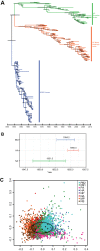Adaptation of pandemic H2N2 influenza A viruses in humans
- PMID: 25505070
- PMCID: PMC4338906
- DOI: 10.1128/JVI.02590-14
Adaptation of pandemic H2N2 influenza A viruses in humans
Erratum in
-
Correction for Joseph et al., Adaptation of pandemic H2N2 influenza A viruses in humans.J Virol. 2015 Apr;89(8):4706. doi: 10.1128/JVI.00259-15. J Virol. 2015. PMID: 25792756 Free PMC article. No abstract available.
Abstract
The 1957 A/H2N2 influenza virus caused an estimated 2 million fatalities during the pandemic. Since viruses of the H2 subtype continue to infect avian species and pigs, the threat of reintroduction into humans remains. To determine factors involved in the zoonotic origin of the 1957 pandemic, we performed analyses on genetic sequences of 175 newly sequenced human and avian H2N2 virus isolates and all publicly available influenza virus genomes.
Copyright © 2015, American Society for Microbiology. All Rights Reserved.
Figures


References
Publication types
MeSH terms
Substances
Grants and funding
LinkOut - more resources
Full Text Sources
Other Literature Sources
Medical

